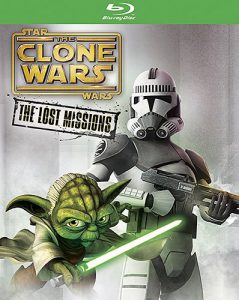While I and most fans will always be irked that “The Clone Wars” wasn’t allowed to bring its character threads to natural conclusions, I have to admit that “The Clone Wars: The Lost Missions”(2014), released in March on Netflix and now available on DVD, hits on several crucial elements and bows out with a beautiful grace note in its final episode, providing a nice framing mechanism with the first Season 1 episode, which likewise featured Yoda.
Before Disney announced the cancellation of the series, these 13 episodes were originally intended to comprise Season 6, with “The Crystal Crisis on Utapau” (episodes 14-17, available as story reels on StarWars.com) and “Darth Maul: Son of Dathomir” (episodes 18-21, available as a trade paperback) rounding out the season.
Ahsoka left the Jedi Order at the end of Season 5, so she doesn’t factor into Season 6 except for one Yoda vision and an Anakin-Obi-Wan conversation about her in the Utapau arc. That leaves a big, albeit purposeful, hole in Season 6. Perhaps we’ll never know if the writers intended to bring her back in Season 7, or if her walk into the sunset was truly the end of her story.
But the absence of Ahsoka isn’t necessarily a problem with “The Lost Missions,” as it seems like a perfect time to delve into Fives, Padme, Jar Jar (yeah, I know I’m in the minority there) and Yoda in four arcs that mark the series at the height of its adult-oriented storytelling. Perhaps the increasingly cerebral direction of “The Clone Wars” somewhat influenced Disney to cancel it and launch the more kid-friendly (at least initially) “Rebels.”
Here are my rankings of the four arcs, followed by my thoughts on the Utapau story reels:
1. The Yoda arc (episode 10, “The Lost One”; 11, “Voices”; 12, “Destiny”; 13, “Sacrifice”; written by Christian Taylor) – What should be left a mystery and what shouldn’t? It’s a debate among “Star Wars” fans that will never be settled. While I lean toward some inexplicable spiritual elements being OK for the saga, I have to admit that almost every time George Lucas lifts the veil, it results in a great yarn, and this exploration of Yoda’s internal strife is a prime example.
In an arc similar to but better than Season 3’s Mortis trilogy, Yoda begins to hear the disembodied voice of Qui-Gon (a pitch-perfect Liam Neeson), and wonders if he’s the victim of Sith trickery. Yoda tells the Council he’s hearing the voice of a dead person but doesn’t say that it’s Qui-Gon, thus preserving Obi-Wan’s surprised reaction to the news at the end of “Episode III.” I love it when Yoda follows Qui-Gon’s voice to Dagobah, which is rendered beautifully, complete with the fog-shrouded treetops of Ralph McQuarrie’s paintings that we didn’t see in “The Empire Strikes Back.”

Then he fights a Gollum-like Dark Yoda on a gas-shrouded Mortis-like planet, and the arc concludes with Yoda being manipulated by Darth Sidious’ magic, as he fights a dream battle against Sidious on an ancient Sith homeworld (Moriband – an alternate name for Korriban?), where he sees Anakin decapitating Dooku in a premonition of “Revenge of the Sith.” Kevin Kiner beautifully weaves in John Williams’ dark side motifs, and Tom Kane brings his A-game to match lines with Neeson; I almost teared up when Yoda calls Ahsoka by her first name rather than “Padawan.” “The Clone Wars” TV series ends on a hopeful note: Yoda understands that the war is unwinnable, but he believes the long game can be won by the forces of good.
2. The Rush Clovis arc (5, “An Old Friend”; 6, “The Rise of Clovis”; 7, “Crisis at the Heart”; Taylor) – Fans had known about these episodes for a long time, as they were originally intended for Season 4, and then Season 5 before Cartoon Network opted to shorten that season to 20 episodes. I’m currently reading the money issue of Reason Magazine and only understanding about half of the words; the same goes for these episodes. But I understand the importance of showing Palpatine centralizing the banks under his rule; controlling the currency is the crucial step in becoming a totalitarian leader. And Padme’s facial expression is in line with the famous “This is how liberty dies” scene, although she stands in shocked silence here.
This arc also features spectacular visuals on the banking planet Scipio, where our heroes are chased through a massive snowscape of tunnels and slopes by bounty hunter Embo. It’s not Hoth cold, but it’s chilly enough that we can see the characters’ breath. A jealous Anakin beating the crap out of Clovis nicely illustrates his dark-side propensity. It’s nice to see Padme again – she had been absent from this series for too long — and it’s nice to hear the late Ian Abercrombie as Palpatine one last time (although in the other “Lost Missions” episodes, Tim Curry improves on his shaky start in late Season 5).
3. “The Disappeared, Parts I and II” (8 and 9, Jonathan Rinzler) – Star Wars Insider Issue 150 revealed that Lucas tasked Rinzler, the author of the “Making of” movie books and scripter of “The Star Wars” comic book, with rehabilitating Jar Jar Binks. Mission accomplished, as the Gungan (voiced by movie actor Ahmed Best) is in character yet also sparked to admirable bravery by his love of Queen Julia of Bardotta. Pairing Jar Jar with the dour Mace Windu provides the right amount of odd-couple humor.
While the “Indiana Jones and the Temple of Doom”-style caverns are evocative, I especially like the starry skies of Bardotta as the backdrop to the final confrontation, which answers another simmering “Clone Wars” mystery: Mother Talzin is not naturally a Force user. Rather, she steals other beings’ Force abilities with help from this cult on Bardotta.
4. The Order 66 arc (1, “The Unknown”; 2, “Conspiracy”; 3, “Fugitive”; 4, “Orders”; Katie Lucas) – Season 6 starts with clone trooper Tup snapping and killing Jedi Tiplar in the field of battle. This moment, which was teased in Dave Filoni’s promise of more “Clone Wars” during the Disney takeover, seems like a launching pad for a great arc. Indeed, I felt like I really got to know an individual clone – Fives – better than ever as he investigates the organic chips that are implanted in all clone embryos. As we expected from the get-go, they are essentially “Order 66 chips,” and Tup’s activated prematurely.
But it doesn’t ring true to me that Anakin would be distrustful of Fives (he argues that Palpatine isn’t capable of the corruption Fives accuses him of) right after Ahsoka was in this same situation of being a fugitive. At the very least, this should’ve been an opportunity for Anakin to express his pain over Ahsoka’s departure, but unfortunately he bottles it up throughout “The Lost Missions.”
While it’s not fair to rank it against the other Season 6 arcs due to being unfinished, now seems like a good time to mention the “Crystal Crisis on Utapau” arc (14, “A Death on Utapau”; 15, “In Search of the Crystal”; 16, “Crystal Crisis”; 17, “The Big Bang”; Daniel Arkin), which can be seen as story reels at StarWars.com.
There are a number of cool things about this arc, including Anakin and Obi-Wan engaged in an old-fashion whodunit, the introduction of the Amana species (like Amanaman from Jabba’s palace) to the series, an entertaining guest turn by James Hong as an arms dealer working with General Grievous, and the use of the oldest “Star Wars” maguffin – a kyber crystal. Alternately spelled kiber or Kaiburr, these crystals date back conceptually to the 1974 rough draft of “The Star Wars” and in the Expanded Universe to the 1978 novel “Splinter of the Mind’s Eye.” Kyber crystals were introduced to “The Clone Wars” in Season 5 when younglings Byph, Gungi, Ganodi, Zatt, Petro and Katooni seek them on Ilum. (In Legends, adegan crystals were used in lightsabers.)
But the best part of the Utapau arc is when Anakin accidentally suggests to Obi-Wan that they call Ahsoka for help before remembering that she had left the Order. Anakin admits that he feels like Ahsoka has failed him (an interesting insight into his mind, but one that makes sense considering that he sticks with the Jedi Order at this point rather than joining her), and that he misses her.
It’s a darn shame that Lucas or Disney couldn’t cough up a few bucks to properly finish these episodes, but they do fall firmly into the “better than nothing” category.
What are your rankings of the arcs of “The Clone Wars: The Lost Missions?” Share your thoughts in the thread below.

